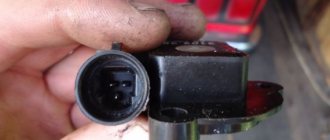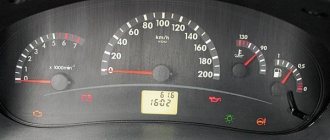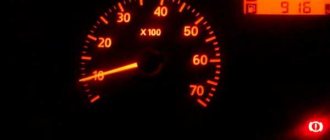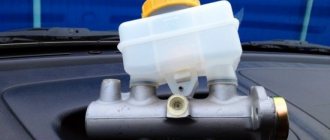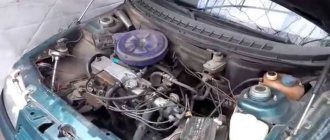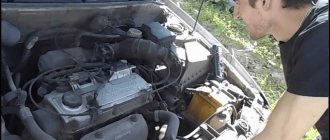Surely every car owner has experienced such an unpleasant situation when the car stalls when releasing the gas.
This problem is one of several most common. To begin with, I would like to clarify why the engine may be plugged during a reset. The very first and most common problem is the banal clogging of the gap in the throttle valve. Another equally popular problem is the dying of the regulator, and they can break quite often.
It’s not uncommon to hear from people that it got to the point where they had to completely change it. Or some people benefit from a very serious and deep flush.
Causes of failure
Before you start repairing your car, you should find out the cause of the problem, and they can be different:
- Most often, the car stalls after filling with low-quality fuel. In this case, the throttle valve becomes clogged.
- The cause may be a failure of the throttle position sensor. By the way, such sensors break quite often, so their replacement may be frequent, especially considering the quality of spare parts that are sold today.
- Some owners do not look for the cause, but immediately flush the entire system, and if flushing does not help, then they delve deeper into the problem.
Air filter
Replacing filters in a car is an important maintenance procedure that many people forget about. As a result, the filter becomes clogged and the operation of the power unit and systems is disrupted. If there is severe contamination or damage, the engine will run unevenly and jerkily—it will stall when you press or release the gas pedal.
Attention! The engine stalls in the same way if the XX regulator fails.
To verify the malfunction, you need to dismantle the filter and inspect for damage. If dirty or worn, replacement is necessary.
Clogged air filter
Sensors
- Idling. This idle speed sensor is installed to control the engine. It is used in cars to achieve stable engine operation and stable idle speed. Often the RPM readings can be unstable and fluctuate. At that moment, the engine may stall if you take your foot off the gas. If there is such a problem, then you can be almost 100% sure that it lies precisely in such a detail. And repairs should begin with the replacement of this part. The sensor works on the principle of supplying air to the engine to maintain stable idle speed. It is very important for the operation of the entire fuel system, which supplies fuel to the engine. The sensor also affects the injection operation. Once it is contaminated, the machine will operate unstably.
- You should also pay attention to the air flow element. It is located in a similar system, but a similar sensor is responsible for more significant work. He is responsible for more operations. If such a sensor stops working as expected, the cause may be poor quality fuel. Therefore, it may make sense to change the gas station or gasoline that the car is fueled with.
Fuel pump is faulty
A fuel pump malfunction may be caused by oxidation of the wires in the connector. The power supply to the fuel pump is unstable, and, as a result, fuel is simply not supplied to the engine. This can be fixed by simply cleaning the contacts. There may also be a problem with the pump itself. Nothing lasts forever, and it can fail. But the most common fuel pump malfunction is contamination of the primary strainer. There is no point in washing it; it is better to buy a new one and replace it.
In this article, we looked at the most common reasons for the engine stopping while driving. If the information presented in the article does not help solve the problem, we strongly recommend that you contact a car service center.
Other problems and solutions
Quite often, cars can stall due to a faulty computer. Incorrect operation may be due to incorrect programming at the factory. In this case, it is recommended to flash the processor with updates. This work can be done by service station technicians.
There are frequent cases of engine stalling caused by a contaminated catalyst. To check, it is recommended to drive the car for a long time, then, after it gets dark, park the car and look under it. If the catalytic converter starts to glow, most likely the problem is a clogged one.
Fuel filter
A dirty fuel filter is another reason why your car stalls when driving. The part is installed on all vehicles. The problem with the device occurs among owners of used cars. The filter is forgotten and rarely changed.
Over time, the dirt fills up, it is difficult for gasoline to pass into the ramp, and there is no combustion chamber. Fuel will arrive intermittently, and then may not arrive. If the filter is clogged, the car stalls when you press the gas pedal.
You need to dismantle the fuel pump, remove the filter and install a new one. There is no point in cleaning it - the cost of the part is small.
Service visit
All the procedures that have been discussed can be done by a person who is familiar with car repairs. But, as a rule, beginners will not be able to find even the XX sensor. If you don’t have enough knowledge, then it’s better not to get into the engine and its system yourself, but to turn to specialists. Intervention on your own can only cause more harm. The cost of repair work in the service may vary. It all depends on why the engine stalls. Maybe it will cost by washing the parts, or maybe even more expensive engine repairs.
What to do if cars with automatic transmission stall?
If your vehicle has an automatic transmission, then the problem should be found in the electrical supply. If you abruptly switch from one gear to another, or while switching gears while braking, the settings may be distorted, and the on-board computer will receive a signal to turn off the engine.
Also, models with automatic transmission may stall due to malfunctions of the hydrodynamic transformers of the gearbox. This problem mainly manifests itself during acceleration and requires urgent intervention from car service specialists.
Eventually
It is worth noting that sometimes in case of the described breakdowns it is better to call a tow truck or ask friends to tow the car to the station. If the car can still drive itself, then, of course, you can drive to the service station on your own.
As a result, as expected, the catalyst was clogged, the air damper was dirty and the MAF was faulty. It was repaired at A2Auto. The catalyst was drilled, the MAF was replaced, the damper was cleaned and adaptation was carried out.
It got to the point that after revving the engine, the engine would stall if the pedal was suddenly released. And the higher the revolutions were, the stronger it “punched” below the minimum, until it stalled. In addition, for some reason, someone increased the idle speed of the engine for some reason in the original (with access to Nissan equipment). Now everything is in the past, idle speed has decreased due to standard adaptation. From time to time, especially with the air conditioner turned off, they fall through, but they immediately get back to normal. Apparently they adapt to electricity consumption. This did not happen before, apparently due to high speed and the fact that the valve was dirty. Consumption has become
Throttle valve
If after all the checks and measurements carried out above it was not possible to identify a malfunction, then all that remains is to check the condition of the throttle valve assembly. To do this, the part should be dismantled and then cleaned of dirt using cotton swabs. The cleaned part (or rather, all its pipes and tubules) is blown with compressed air using a compressor.
Special attention should be paid to the channel that serves to remove gases from the crankcase. Before starting purging, it should be filled with a cleaning compound and allowed to stand for some time, after which the purging itself should be performed. This is caused by the extremely small diameter of the internal channel, as a result of which other methods of cleaning it are simply not available.
In addition to all of the above breakdowns, a breakdown of the DPKV sensor, as well as the Hall sensor, can also lead to “floating” speed. If they fail, the Check Engine light will light up on the car panel. If such a malfunction occurs, it is best to contact a service center, since special equipment is required to check these sensors.
Problems and their solutions
The car stalls when you let off the gas - but what exactly lies behind this problem? Everything is quite simple, after reaching a certain speed, the foot is removed from the gas pedal and the car simply stalls. With all this, when the ignition is applied and at idle, everything works more than with a bang.
Despite the advice given above, the problem may not be solved, since they are general preventive measures for a stalled engine. As for the problem itself, it’s worth paying attention to several sensors.
Fuel quality
One of the reasons is low quality gasoline, which does not meet the octane requirements for the car. The driver needs to remember where and what kind of gasoline the vehicle was last filled with. If it is indicated that the motor should run on AI-95 or AI-98, pouring AI-92 into the tank is dangerous.
The problem is caused by fuel - when you press the gas pedal fully, the speed does not pick up, and when the clutch is depressed, the power unit stalls. The situation is explained by the weak spark produced by poor fuel.
To fix the problem you need to:
- Drain fuel.
- Wash the motor.
- Clean all fuel system pipes.
- Change the fuel filter.
Car engines are sensitive to fuel quality.
Sensors
The first of them is the idle speed sensor. This device is located in the engine control system. It is used in cars to stabilize idle speed. Its abrupt performance often precedes the engine turning off when the gas pedal is released. If this is exactly the sequence, then with a 90% probability this particular sensor is involved and you need to start digging in its direction.
As you can understand, this sensor is designed to supply air to the engine to maintain normal idle speed. This sensor is a very important component of the entire fuel supply system to the engine, and it works closely with the injection system.
Second
– this is an air flow sensor, it is located in the same system as the previous one, only it works more globally and is responsible for a greater number of operations.
If this is not the problem, then you can look towards low-quality gasoline (this happens, and not rarely). So, you should pay great attention to the selection of gasoline. Additional article “Which cars require 98 gasoline.”
After revving the VAZ 2114, the speed drops
Hi all. We have the following problem: a VAZ-2114 car, manufactured in 2007, mileage 80,000 km, with power consumers (headlights, heater, etc.) on, the car almost stalls when the gas is released, the revolutions drop to 400-500. If you turn everything off, the motor works as it should. If you remove the wires from the generator, then everything works fine, because of this, the first thing they did was change the generator, it didn’t help. Then it was replaced: (or checked) IAC (2 times) DMRV spark plugs Measured compression (everywhere 12) Measured pressure in the fuel rail (about 3 points) Removed the fuel pump to check the mesh (perfectly clean) Reflashed the ECU Straightened the mass on the body, engine, ECU The throttle has been washed. There seems to be no air leakage from the mass air flow sensor to the throttle. Charging OK
Nothing helped! There is a suspicion that the 1st injector is faulty, because... In the 1st cylinder the spark plug is all smoked.
For clarity, I am posting a video of a faulty car (link No. 1) and for an example video (link No. 2) of the same car with all power consumers turned on (the standard, as it should be :))
Source
A trip to the workshop
As you can see, everything described above can be done by a person who knows the structure of the car, but there is nothing for a beginner, because not every novice car enthusiast knows where the XX valve is located, much less its sensor. There is a high probability that outside interference will only make everything worse, or will break or spoil something that was originally in working order. So here it’s worth setting priorities and logically assessing your chances of correcting all problems yourself.
Naturally, in moments when the car stalls when releasing the gas, few people are interested in why this is happening, so it would be very advisable to call a tow truck and tow the car for repairs, or, if the situation is not completely dire, then you can drive to the repair shop yourself .
The price for correcting problems will directly depend on their cause; if it is a simple flushing of sensors and valves, then it will not be very high.
Spark plug
The first thing worth checking when looking for the reasons for floating speed on a VAZ 2114 (injector) is the spark plugs. Unscrew them and inspect their condition. They should not be oxidized, uneven soot, oil, etc. They should have a brown or gray-brown soot, without any deposits. If so, the spark plugs are in working order. In cases where the replacement took place a long time ago, it is more advisable to immediately replace them with new ones, regardless of the condition. Remember that spark plugs need to be replaced every 20-30 thousand kilometers. If a warmed-up engine returns to normal operation, then this is another sign to look for a problem in the spark plugs.
After revving the VAZ 2114, the speed drops
Hi all. We have the following problem: a VAZ-2114 car, manufactured in 2007, mileage 80,000 km, with power consumers (headlights, heater, etc.) on, the car almost stalls when the gas is released, the revolutions drop to 400-500. If you turn everything off, the motor works as it should. If you remove the wires from the generator, then everything works fine, because of this, the first thing they did was change the generator, it didn’t help. Then it was replaced: (or checked) IAC (2 times) DMRV spark plugs Measured compression (everywhere 12) Measured pressure in the fuel rail (about 3 points) Removed the fuel pump to check the mesh (perfectly clean) Reflashed the ECU Straightened the mass on the body, engine, ECU The throttle has been washed. There seems to be no air leakage from the mass air flow sensor to the throttle. Charging OK
Nothing helped! There is a suspicion that the 1st injector is faulty, because... In the 1st cylinder the spark plug is all smoked.
For clarity, I am posting a video of a faulty car (link No. 1) and for an example video (link No. 2) of the same car with all power consumers turned on (the standard, as it should be :))
Source
Checking the idle air control
One of the reasons that the car stalls at low speeds is a malfunction of the idle air control (IAC). It should be tested to either rule out this cause or troubleshoot. There are several ways to check the serviceability of the IAC on the VAZ-2110:
- With the ignition off, connect the multimeter probes to the power supply. When they are connected, turn on the ignition and check the integrity of the winding and the power supply circuit in the following order: first, the probes are connected to pins 1 and 2. When the IAC is working properly, readings from 50 to 80 ohms appear on the multimeter sensor. When testing the 2nd and 3rd pins, as well as the 1st and 4th pins, there should be indicators indicating an infinite value.
- Visual inspection method. It is necessary to remove the regulator, disassemble it and determine the degree of coking, the degree of wear of the spring and other elements of the regulator. It is quite easy to visually determine that the regulator is simply time to change.
- It is still possible to carry out diagnostics using special testers, but purchasing such a tester will cost much more than replacing the part itself. It's up to you to decide whether it's worth purchasing such a device.
The engine stalls when releasing gas VAZ 2110 8 valve injector
it seems that only GM suffered from this,
it seems that only GM suffered from this
and view contacts on the DMRV?
and view contacts on the DMRV?
Maybe it's time, I'll look there then.
And I wanted to ask if the brains (firmware) could be bugged like this? or is this a more ironclad problem? By the way, I recently replaced the battery, now error 1602 constantly appears, how can I clear it?
And I wanted to ask if the brains (firmware) could be bugged like this?
500-600 rev/m -When you press the brake in a parking lot, the speed does not drop (it was a mistake on VUT) -if you put it in gear after it stalled, it starts perfectly
I also noticed that an error appeared on the BC about a loss of voltage on the ECU (I did not reset the battery), cleared the error, drove on (stall), but the error did not appear again. I thought about a generator, but when the consumers are disconnected, it still stalls.
this has been going on for a long time and it’s unclear where it came from)
I checked the mass of the battery and engine with a tester. I didn't seem to find anything. I haven't touched the ECU yet. Today I replaced the canister purge valve, apparently it had already been changed before me, the latches were slightly loose, but the valve seemed to be holding tightly. I looked at the BC at XX temperature 88-90 RPM 840-880 Air consumption: 13.6-13.8 Pitch: 34-38 DC: 0.01-0.7 Gasoline consumption/h: 0.9l
Speed: 2400-2500\min air consumption: 26-27 Pitch: 78-80 DC: 0.01-0.7 Gasoline consumption/h: 2.3l
Are these indicators normal? and why does the DC show the same thing at different speeds, and the range of readings is so wide? Maybe it's time for DK to be trashed?
Source
